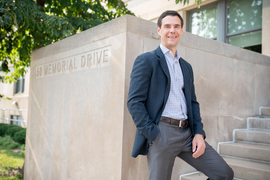The U.S. is a land of opportunity, but it’s a complicated thing. People in the workforce today are much less likely to earn more than their parents did, compared to people born around 1940. Some parts of the country generate much more economic mobility than others. And even with other matters being equal, there are still large differences in mobility among racial and ethnic groups.
Professor Nathaniel Hendren PhD ’12 has spent the last decade studying these matters. An economist who just joined the MIT faculty this summer, Hendren has co-authored a series of published papers with important empirical results shedding light on the conditions of opportunity in the U.S. today.
For instance, 92 percent of people born in 1940 earned more than their parents, but only 50 percent of those born in 1984 are doing so, with the middle class experiencing the biggest change. This is only modestly due to changes in the rate of GDP growth, the research shows, and is much more because of the way income inequality has grown, restricting middle-class gains.
Where people live affects their prospects, too. A child in the bottom quintile of the national income distribution growing up in San Jose, California, is about three times more likely to reach the top quintile than a bottom-quintile child in Charlotte, North Carolina. All of this interacts with race and ethnicity; even when accounting for levels of parental income, Black boys will have lower incomes in adulthood than white boys will in 99 percent of U.S. census tracts.
“It opens up a lot of questions about what historical [issues and] policies have done, and how they led to low income mobility today,” Hendren says. “It is a landscape that is affected by our institutions and policies.”
And by our places. Hendren’s research has shown there is a neighborhood-level impact on economic outcomes, one that corresponds to the number of years children live in a particular place.
“We are sort of a weighted average of the neighborhoods we grew up in,” Hendren says.
To be sure, many policies aim to provide better opportunities for people. In another area of his research, Hendren has developed new tools for comparing the usefulness of programs, while serving as founder and co-director of Policy Impacts, a nonpartisan group supporting evidence-based policymaking.
“Historically, over the last 50 years, the policies that provide the biggest returns are those that make direct investments in kids, especially low-income kids,” Hendren says. “It’s not necessarily cash transfers to their parents or things that might spill over. It’s investments in their schools, their health, direct investments in those kids.”
Off to the races
Hendren’s arrival in the faculty ranks at MIT represents an intellectual homecoming, given that he earned his PhD at the Institute. His interest in the field began to flower as an undergraduate at the University of Chicago, though, where he double-majored in math and economics.
“I always liked that you can be formal about describing social interactions or human behavior with math, and that the precision of math disciplined the theories that you have and the statements you can make,” Hendren says.
After joining the doctoral program at MIT, Hendren worked with Daron Acemoglu and Amy Finkelstein as his primary advisors, producing a thesis with research on insurance markets.
“I came here and just never looked back. I found I enjoyed doing research, and it was off to the races at that point,” Hendren says.
Hendren has been producing notable research at racing speed ever since. As a newly minted Institute PhD in 2012, Hendren joined the faculty at Harvard University and soon started focusing on matters of opportunity and social mobility. Working with a series of co-authors, including Raj Chetty, Lawrence Katz, and Emmanuel Saez, he has published over two dozen papers in major journals.
Hendren has also co-authored some papers with Finkelstein on the impact of health insurance programs, and he sometimes studies market failure issues. But much of his work has centered directly on social mobility, including research designed to test individual policy ideas.
In one 2016 paper, Chetty, Hendren, and Katz examined the Moving to Opportunity program, which gives poor families vouchers to help with housing in lower-poverty neighborhoods, and found that children in families participating in the program eventually realized 31-percent gains in income as adults.
In a related paper, forthcoming in the American Economic Review, Chetty, Hendren, Katz, MIT economist Christopher Palmer, and additional co-authors ran an experiment with a housing voucher program in the Seattle area. By supplying low-income families with a “navigator” who provided some of the services of a real estate agent and financial advisor, participants’ use of the vouchers increased from 15 percent to 53 percent.
“We found remarkably large effects when you provide people with these navigators,” Hendren notes. “It’s a pretty low-touch intervention for such a large life change.”
That kind of result, Hendren notes, “rules out this story about how [housing] segregation is driven by the preferences of the segregated. I think it’s driven by the constraints imposed on them by institutions, and people [altering] the rules of the game.” He adds: “Our results suggest that a lot of people want to live in neighborhoods that promote higher upward mobility for their kids, and are willing to make tradeoffs to do that.”
Measuring what works
Historically, Hendren notes, residential segregation has been embedded in sweeping currents in American life; even when millions of Black families left the segregated Jim Crow South during the so-called Great Migration in the mid-20th century, their arrival in northern cities caused extensive “white flight” from cities to suburbs. Individual programs like Moving to Opportunity can work, but there are large-scale hurdles to creating sustainably diverse communities that enourage social mobility.
“Our results suggest we create places with high upward mobility, but they are enclaves with barriers that prevent [many] people from accessing those places,” Hendren says.
And yet, given that governments have created a wide array of measures designed to encourage education, economic advancement, public health, a cleaner environment, and many other things that can influence social outcomes, Hendren in recent years has been working to redefine the bottom-line measurement of those programs.
“We’re trying to create coherent, consistent measures of what a policy does,” Hendren says. Studies across topics from education to the environment to public health use differing metrics to evaluate policies, but Hendren and economist Ben Sprung-Keyser have worked to align them in a common framework, developing a metric they call “the marginal value of public funds” and applying it to 133 different types of government policies.
“It’s really a simple metric,” Hendren says. “For every dollar the government spends on a policy on net, how much benefit does the policy provide to its beneficiaries in dollar terms?”
This is the research showing that spending on lower-income children provides the biggest additional return per dollar spent. Which is not to say that other programs are not worthy. But policymakers can use this kind of analysis in allocating their budgets.
To be sure, even clearly effective policy ideas can struggle to make it through any given legislative chamber. Still, Hendren notes, it is valuable to have the solid, firm facts and opportunity, mobility, and policy on hand for everyone to use.
“Politics is sticky and messy,” Hendren says. “My view of social change and politics is maybe a little rosy and optimistic, but if I don’t have that view, I won’t stay motivated. If we can measure the tradeoffs that we think are true, based on our best estimates, and shine a light on the implicit preferences that a politician has to support one policy over another, then I think we can make a little bit of progress.”










